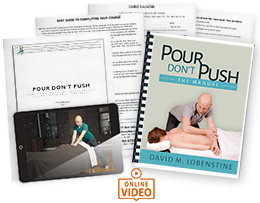14 Hour CE Course

Un-learn the counterproductive habits that you have accumulated and re-learn that passion you used to have for your work. We are too determined to make our clients feel better. The result: we work too hard. We try to push our clients into feeling better. But what if we pour rather than push? With Pour Don't Push you will learn how to massage with greater depth and ease.
Let instructor David Lobenstine guide you in facilitating change, rather than force change, in your clients. In this online video and text based home study course you will rediscover your most powerful therapeutic tools—your breath and your body weight. These innate tools are what make us great therapists, and yet are the same tools we so often forget. The more sessions we do, the more we tend to rely on our muscles, the more we become convinced that we need to force our client into letting go.
Here we will see the results of the opposite approach—the “pouring principle.” As you contact your client with ease, you help your client become an engaged partner in the work; in turn, you can put the “deep” back in deep tissue massage, but without strain or pain.
Some of the information you’ll investigate in this course includes:
One of the greatest gifts we can give to our clients is to not try to do so much. In “Pour Don’t Push,” we discover that a massage session is often more effective – and feels better! – if you work slower rather than faster, and if you do fewer strokes rather than more.
-David Lobenstine
This is one of the best trainings I have come across that benefits both the therapist and the client. Highly recommend. Look forward to learning and using this in my practice.Kimberly Hood, LMT
Really enjoyed the courseLauren Davis, LMT


Take our free online course: Ethics Refresher
We will not rent/sell your email to anyone.
You'll also receive our newsletter and special offers.
Thank you! An email will be sent to the address provided with instructions on how to enroll in this 1 CE hour course - FREE!
If you do not see our email within a few minutes of signing up, please check your Spam/Junk folders it may have been delivered there instead of your inbox.
If, by chance, you still have not received it within 5 minutes, please call us at 1-800-364-5722, Monday-Friday, 9am-5pm EST for assistance.